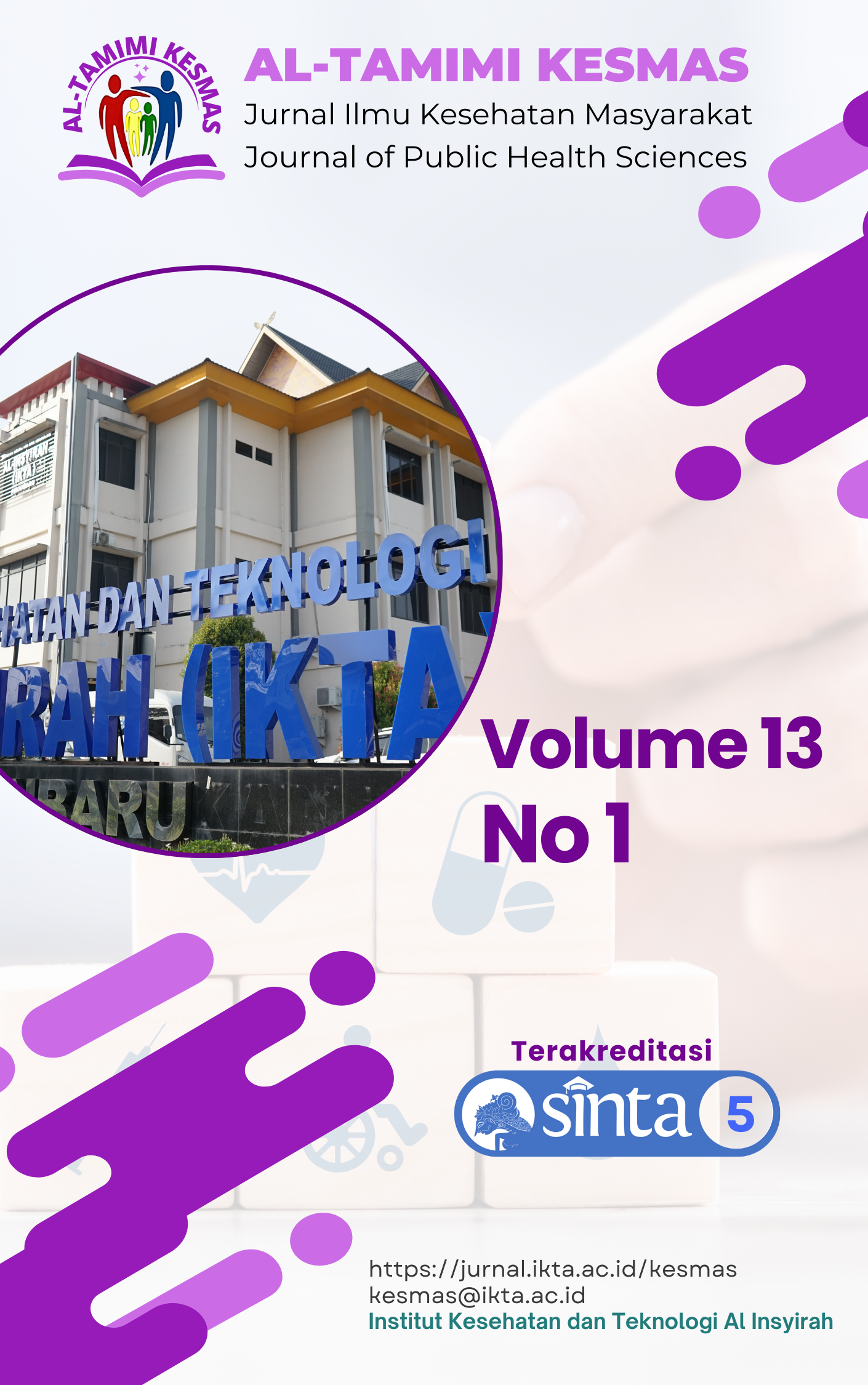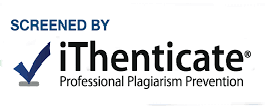PENGARUH RIWAYAT PEMBERIAN ASI EKSKLUSIF TERHADAP KEJADIAN STUNTING PADA BALITA
DOI:
https://doi.org/10.35328/kesmas.v13i1.2680Keywords:
Toddlers, Exclusive Breastfeeding History, StuntingAbstract
The prevalence of stunting in Indonesia remains high at 21.6%. One of the contributing factors to stunting in toddlers is an unbalanced diet, including insufficient exclusive breastfeeding. This study aims to evaluate the influence of the history of exclusive breastfeeding on the incidence of stunting. It is an analytical observational study with a cross-sectional design. The study population includes all mothers who bring their toddlers to the Garuda Public Health Center, with 225 samples selected using the accidental sampling method. The study was conducted at the Garuda Public Health Center from June to December 2023. Research instruments included questionnaires and height measurement tools. Data analysis was performed using univariate and bivariate analyses with the chi-square test. Results showed that the majority of respondents (59.1%) provided exclusive breastfeeding. Most respondents had normal nutritional status, with 164 individuals (72.9%). Bivariate analysis revealed that the majority of respondents who did not provide exclusive breastfeeding experienced stunting (34 individuals or 55.7%), while the majority who provided exclusive breastfeeding had normal nutritional status (106 individuals or 64.6%). The chi-square statistical test yielded a p-value of 0.006, indicating a correlation between the history of exclusive breastfeeding and the incidence of stunting. It is recommended that mothers provide exclusive breastfeeding according to the child's nutritional needs to prevent stunting.
References
Adam, D., Hatta, H., Djafar, L., & Ka, I. (2021). Hubungan Pola Makan dan Riwayat ASI Ekslusif Dengan Kejadian Stunting Pada Balita di Kabupaten Gorontalo. Public Health Nutrition Journal, 1(1).
Adriani, P., Aisyah, I. S., Wirawan, S., Hasanah, L. N., Idris, Nursiah, A., Yulistianingsih, A., & Siswati, T. (2022). Stunting Pada Anak. PT Global Teknologi.
Dinkes, R. (2024). Profil Dinas Kesehatan Riau.
Fildzah, F. K., Yamin, Ah., & Hendrawati, S. (2020). Perilaku Ibu Dalam Pencegahan Stunting Pada BADUTA. Jurnal Keperawatan Muhammadiyah, 5(2).
Hizriyani, R., & Aji, T. S. (2021). Pemberian ASI Eksklusif Sebagai Pencegahan Stunting. Jurnal Jendela Bunda, 8(2).
Ika Pramulya S , Fiki Wijayanti, M. S. (2021). Hubungan Pemberian Asi Eksklusif Dengan Kejadian Stunting Pada Balita Usia 24-60 Bulan. Jurnal Kesehatan Kusuma Husada, 20(1).
Islami, N. W., Khouroh, U. (2021). Analisis faktor-faktor yang mempengaruhi balita stunting dan tantangan pencegahannya pada masa pandemi. Karta Raharja, 3(2).
Kemenkes., R. (2021). Infodatin Pusat Data Dan Informasi Kementerian Kesehatan RI Situasi Dan Analisis ASI Eksklusif.
Kemenkes RI. (2021). Profil Kesehatan Indonesia Tahun 2020.
Komalasari, K., Supriati, E., Sanjaya, R., & Ifayanti, H. (2020). Faktor-Faktor Penyebab Kejadian Stunting Pada Balita. Majalah Kesehatan Indonesia, 1(2).
Luh Herry Novayanti , Ni Wayan Armini, J. M. (2021). Hubungan Pemberian ASI Eksklusif dengan Kejadian Stunting pada Balita Umur 12-59 Bulan di Puskesmas Banjar I Tahun 2021. Jurnal Ilmu Kebidanan, 9(2).
Mirza Refky Pratama, S. I. (2021). Hubungan Pemberian Asi Eksklusif Dengan Stunting Di Puskesmashinai Kiri, Kecamatan Secanggang, Kabupaten Langkat. Jurnal Kedokteran STM (Sains Dan Teknologi Medik, 4(1).
Nabilah Khairunnisa Rahayu, Arief Budi Yulianti, R. S. H. (2023). Pengaruh Pemberian ASI Eksklusif terhadap Kejadian Stunting pada Balita di Desa Tanjung Wangi Cicalengka. Bandung Conference Series: Medical Science, 3(1).
Nirmalasari, N. (2020). Stunting Pada Anak : Penyebab dan Faktor Risiko Stunting di Indonesia. Qawwam J Gend Mainstreming, 14(1).
Noorhasanah, E., Tauhidiah, N. I., & Putri, M. C. (2020). Faktor- Faktor Yang Berhubungan Dengan Kejadian Stunting Pada Balita Di Wilayah Kerja Puskesmas Tatah Makmur Kabupaten Banjar. Journal of Midwifery and Reproduction, 4(1).
Nugroho, M. R., Sasongko, R. N., & Kristiawan, M. (2021). Faktor-faktor yang Mempengaruhi Kejadian Stunting pada Anak Usia Dini di Indonesia. Jurnal Obsesi : Jurnal Pendidikan Anak Usia Dini, 5(2).
Nur Hikmah Wati Soekotjo, KFadli Ananda, Rezky Putri Indarwati Abdullah, A. Husni Esa Darussalam, R. A. E. (2023). Faktor Penghambat Pemberian Asi Eksklusif pada Ibu Menyusui. Jurnal Mahasiswa Kedokteran, 3(10).
Putra Pratama RS, Dasuki MS, Agustina T, S. S. (2022). ASI Eksklusif Sebagai Faktor Protektif Terhadap Kejadian StuntingPada Balita 24-59 Bulan. Ilmu Kesehat Sandi Husada, 11(1).
Quamme, S. H., & Iversen, P. O. (2022). Prevalence of child stunting in Sub-Saharan Africa and its risk factors. Clinical Nutrition Open Science, 42(3).
Safitri, Yeni, Nurul Husnul Lail, and T. I. (2021). . F aktor-Faktor Yang Berhubungan Dengan Kejadian Stunting Pada Balita Dimasa Pandemi Covid-19 Wilayah Kerja Puskesmas Gunung Kaler Tangerang. For Quality in Women’s Health, 4(1).
Sarman, D. (2021). Hubungan ASI Eksklusif dan Paritas dengan Kejadian Stunting pada Anak Usia 6-12 Bulan di Kota Kotamobagu. Studi Retrospektif. Gema Wiralodra, 12(2).
Sr. Anita Sampe, SJMJ, Rindani Claurita Toban, M. A. M. (2020). Hubungan Pemberian ASI Eksklusif Dengan Kejadian Stunting Pada Balita. Ilmiah Kesehatan Sandi Husada, 11(1).
Sumiwi, M. E. (2024). Panduan Kegiatan MP-ASI Kaya Protein Hewani Cegah Stunting.
Tello, B., Rivadeneira, M. F., Moncayo, A. L., Buitrón, J., Astudillo, F., Estrella, A., & Torres, A. L. (2022). Breastfeeding, feeding practices and stunting in indigenous Ecuadorians under 2years of age. International Breastfeeding Journal, 17(1).
Wardani, S. (2020). An investigative study: Why does stunting still happen in Indonesia? Technology Reports of Kansai University, 62(4).
Zurhayati, Z., & Hidayah, N. (2022). Faktor Yang Berhubungan Dengan Kejadian Stunting Pada Balita. JOMIS (Journal of Midwifery Science, 6(1).
Downloads
Published
Issue
Section
License
Copyright (c) 2024 Al-Tamimi Kesmas: Jurnal Ilmu Kesehatan Masyarakat (Journal of Public Health Sciences)

This work is licensed under a Creative Commons Attribution 4.0 International License.














